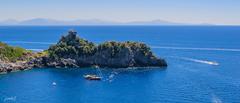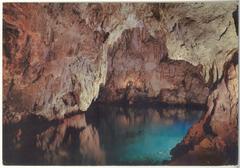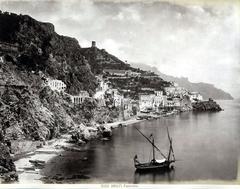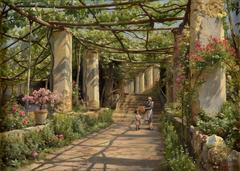
Navigating the Amalfi Coast: A Comprehensive Guide to the Strada Statale Amalfitana
Date: 18/07/2024
Introduction
The Amalfi Coast, one of Italy’s most iconic and picturesque destinations, is home to the famous Strada Statale Amalfitana, also known as the Amalfi Drive. This historic coastal road winds through stunning landscapes, offering breathtaking views of the Mediterranean Sea and the rugged cliffs of the Sorrentine Peninsula. The Amalfi Drive is not just a scenic route; it is a journey through centuries of history, showcasing human engineering ingenuity and the rich cultural heritage of the region. Recognized as a UNESCO World Heritage Site, the Amalfi Coast is celebrated for its outstanding universal value, encompassing dramatic natural landscapes, historical significance, and vibrant cultural traditions. This comprehensive guide provides essential information on visiting hours, ticket prices, travel tips, and recommendations for making the most of your journey along this remarkable coastal road.
Table of Contents
- Introduction
- Historical Significance
- Visitor Information
- Nearby Attractions and Special Events
- Cultural Gems
- Culinary Delights
- Practical Travel Tips and Recommendations
- Conclusion
Historical Significance
Roman Beginnings and Medieval Expansion
While the exact date of the road’s initial construction remains uncertain, historians believe that a rudimentary coastal path existed during the Roman era, serving as a trade route connecting the bustling Roman towns of Sorrento and Amalfi. It was significantly expanded during the medieval period under the Duchy of Amalfi (9th-12th centuries). The powerful maritime republic invested in transforming the coastal path into a secure and efficient passage for merchants and travelers.
Bourbon Dynasty and the Birth of a Scenic Route
Despite medieval improvements, the road remained challenging for centuries. In the early 19th century, under the reign of the Bourbon King Ferdinand II of the Two Sicilies, major renovations were undertaken. Between 1832 and 1850, the road was widened, bridges and viaducts were constructed, and retaining walls were built to prevent landslides. These improvements made the road safer and more accessible, eventually opening it up to carriages and automobiles.
From Vital Artery to Tourist Destination
The completion of the Amalfi Drive under Ferdinand II marked a turning point. It began attracting visitors captivated by its beauty, leading to a surge in tourism in the late 19th and early 20th centuries. This influx further fueled the development of towns along the route, transforming them into popular tourist destinations.
UNESCO World Heritage Site and Modern Challenges
In 1997, the Amalfi Coast, including the Strada Statale Amalfitana, was designated a UNESCO World Heritage Site. This recognition acknowledged the area’s outstanding universal value, encompassing its dramatic natural landscape, rich history, and cultural heritage. The Amalfi Drive remains a symbol of the region’s beauty and allure.
Visitor Information
Visiting Hours
The road is accessible year-round, but the best times to visit are during spring and fall to avoid the peak summer crowds.
Tickets
There is no entrance fee to drive along the Amalfi Drive, but parking in the towns along the route may incur charges.
Travel Tips
- Rent a small car for easier navigation through narrow sections.
- Start your journey early in the day to avoid traffic.
- Consider taking guided tours for a more comprehensive experience.
Nearby Attractions and Special Events
Amalfi Cathedral
A stunning example of medieval Roman Catholic architecture.
Villa Rufolo in Ravello
Known for its beautiful gardens and panoramic views.
Positano
Famous for its colorful buildings and charming streets.
Annual Events
The Ravello Festival, featuring music and arts, and the Feast of St. Andrew in Amalfi.
Cultural Gems
Amalfi
-
Duomo di Amalfi (Amalfi Cathedral): This architectural marvel, with its Arab-Norman design and striking facade, dominates the Piazza del Duomo. Climb the steps to the Cloister of Paradise, a tranquil oasis with Moorish influences, and visit the crypt, home to the relics of Saint Andrew. (Duomo di Amalfi)
- Visiting Hours: 9:00 AM - 7:00 PM (may vary seasonally)
- Tickets: €3 for adults, free for children under 12
-
Museo della Carta (Paper Museum): Discover the ancient art of papermaking in Amalfi, once a renowned paper production center. Explore the museum’s historic machinery and learn about the traditional methods used to create beautiful, handcrafted paper. (Museo della Carta)
- Visiting Hours: 10:00 AM - 6:30 PM
- Tickets: €4 for adults, €2 for children
Positano
-
Chiesa di Santa Maria Assunta: This iconic church, with its majestic dome adorned with majolica tiles, is a symbol of Positano. Inside, admire the Byzantine icon of the Black Madonna, believed to have miraculous powers.
- Visiting Hours: 8:00 AM - 8:00 PM
- Tickets: Free entry
-
Franco Senesi Museum: Art enthusiasts will appreciate this museum dedicated to the works of Franco Senesi, a prominent Italian artist who found inspiration in Positano’s beauty. The museum houses a collection of his paintings, sculptures, and ceramics.
- Visiting Hours: 9:00 AM - 7:00 PM
- Tickets: €5 for adults, free for children under 10
Ravello
-
Villa Rufolo: Step back in time at this 13th-century villa, renowned for its stunning gardens, breathtaking views, and historical significance. Wagner found inspiration for his opera “Parsifal” within these very gardens. (Villa Rufolo)
- Visiting Hours: 9:00 AM - 8:00 PM
- Tickets: €7 for adults, €5 for students
-
Villa Cimbrone: Perched on a cliff edge, Villa Cimbrone offers unparalleled panoramic views of the coastline. Wander through its meticulously manicured gardens, adorned with sculptures and fountains, and discover the “Terrace of Infinity,” offering a seemingly endless vista of the sea. (Villa Cimbrone)
- Visiting Hours: 9:00 AM - Sunset
- Tickets: €7 for adults, €4 for students
Other Cultural Experiences
- Ceramics Shopping: The Amalfi Coast is renowned for its vibrant ceramic art. From hand-painted tiles to colorful tableware, you’ll find a plethora of ceramic treasures in shops throughout the region, particularly in Vietri sul Mare, known as the “Ceramics Capital of the Coast.”
- Limoncello Factory Tour: No trip to the Amalfi Coast is complete without indulging in its signature liqueur, limoncello. Take a tour of a local limoncello factory to learn about the traditional production process, from harvesting the lemons to the final bottling, and enjoy a tasting of this refreshing drink.
- Visiting Hours: Typically 9:00 AM - 5:00 PM
- Tickets: Usually free, but tastings may have a small fee
Culinary Delights
Seafood
- Spaghetti alle Vongole: This classic Italian dish features fresh clams, garlic, white wine, and a touch of chili, creating a light and flavorful pasta dish that embodies the essence of coastal cuisine.
- Frittura di Paranza: Indulge in a platter of freshly caught, lightly fried seafood, including anchovies, squid, and prawns, offering a taste of the Mediterranean’s bounty.
Local Specialties
- Ndunderi: Originating in Minori, ndunderi are small, gnocchi-like dumplings made with ricotta cheese, flour, and semolina, often served with a simple tomato sauce or a rich ragu.
- Sfogliatella: This shell-shaped pastry, filled with ricotta cheese, candied fruit, and spices, is a beloved dessert on the Amalfi Coast. Enjoy it with a cup of espresso for a true taste of Italian indulgence.
Drinks
- Limoncello: Made with locally grown lemons, sugar, and alcohol, limoncello is a refreshing liqueur best enjoyed chilled as a digestif.
- Fiano di Avellino: This crisp, dry white wine, produced in the nearby Avellino region, pairs perfectly with the region’s seafood and pasta dishes.
Culinary Experiences
- Cooking Class: Immerse yourself in the art of Italian cooking by participating in a hands-on cooking class. Learn to prepare traditional Amalfi Coast dishes using fresh, local ingredients and savor the fruits of your labor.
- Farm-to-Table Dining: Experience the true essence of Amalfi Coast cuisine by dining at a farm-to-table restaurant. These establishments prioritize fresh, locally sourced ingredients, showcasing the region’s agricultural bounty and culinary traditions.
Practical Travel Tips and Recommendations
Best Time to Visit
The Amalfi Coast enjoys a Mediterranean climate with warm, dry summers and mild, wet winters.
- Shoulder Seasons (April-May & September-October): Offer the ideal balance of pleasant weather, fewer crowds, and lower prices.
- Summer (June-August): The most popular time to visit, expect higher temperatures, more tourists, and increased prices.
- Winter (November-March): While quieter, some businesses, particularly hotels and restaurants, may have limited hours or be closed.
Getting There and Around
- By Air: Naples International Airport (NAP) is the closest major airport. From there, you can rent a car, take a private transfer, or utilize public transportation.
- By Train: The nearest train station is in Salerno, with connecting regional trains to towns along the coast.
- By Car: Driving the Amalfi Coast offers scenic freedom but can be challenging due to narrow, winding roads and limited parking. Consider your comfort level and driving experience.
- By Bus: SITA buses are a cost-effective and convenient way to travel between towns. Be prepared for crowded buses, especially during peak season.
- By Ferry: Ferries connect major towns along the coast, offering stunning views and a different perspective.
Pro Tip: Consider a combination of transportation methods for the best experience. For instance, take the bus for scenic coastal drives and utilize ferries for hopping between towns.
Where to Stay
The Amalfi Coast offers a range of accommodation options to suit every budget and preference:
- Positano: Known for its picturesque cliffside setting and upscale boutiques.
- Amalfi: The region’s namesake town, offering a lively atmosphere and historical attractions.
- Ravello: Perched high above the coast, renowned for its breathtaking views and tranquil ambiance.
- Praiano: A quieter alternative with charming streets and stunning sunsets.
- Atrani: A hidden gem with a picturesque beach and authentic Italian charm.
Pro Tip: Book your accommodation well in advance, especially if traveling during peak season.
Must-See Attractions
- Strada Statale Amalfitana: The iconic coastal road itself is an attraction, offering breathtaking views at every turn.
- Positano: Explore the colorful houses cascading down the hillside, relax on Spiaggia Grande beach, or hike the Path of the Gods for panoramic vistas.
- Amalfi: Visit the Duomo di Amalfi, wander through the charming alleys, and soak up the vibrant atmosphere.
- Ravello: Explore the gardens of Villa Rufolo and Villa Cimbrone, renowned for their stunning coastal views.
- Path of the Gods: Embark on this unforgettable hiking trail connecting Agerola to Nocelle, offering breathtaking panoramic views.
- Fiordo di Furore: Discover this hidden gem, a fjord carved into the cliffs, with a small beach and emerald-green waters.
- Emerald Grotto: Take a boat tour to this mesmerizing sea cave, illuminated by an ethereal emerald glow.
Visitor Information
- Tickets: Entry to attractions like Villa Rufolo or Emerald Grotto usually requires a ticket. Prices vary, so check the official websites for the most current information.
- Opening Hours: Many attractions and businesses have seasonal hours. Always verify opening times in advance to avoid disappointment.
- Accessibility: The terrain can be challenging with many stairs and steep paths, making it less accessible for those with mobility issues. Plan accordingly.
Food and Drink
Indulge in the flavors of Campania with these culinary experiences:
- Scialatielli ai frutti di mare: Fresh pasta with seafood, a local specialty.
- Melanzane alla Parmigiana: A classic Italian dish of eggplant, tomato sauce, and mozzarella cheese.
- Limoncello: The region’s famous lemon liqueur, best enjoyed chilled after a meal.
- Local seafood: Sample the freshest catches of the day, prepared with simple yet flavorful ingredients.
Pro Tip: Venture beyond the tourist hotspots to discover family-run trattorias and experience authentic local cuisine.
Additional Tips
- Pack light: The Amalfi Coast involves a lot of walking and navigating stairs.
- Learn basic Italian phrases: While English is widely spoken in tourist areas, knowing a few basic phrases will enhance your interactions with locals.
- Be prepared for crowds: The Amalfi Coast is a popular destination, especially during peak season.
- Embrace the slower pace of life: Relax, savor the scenery, and enjoy the journey.
- Stay hydrated: Carry a reusable water bottle and refill it throughout the day.
- Protect yourself from the sun: Wear sunscreen, a hat, and sunglasses, especially during the summer months.
- Be aware of your belongings: As with any tourist destination, be mindful of your belongings and take necessary precautions.
Pro Tip: Consider purchasing a travel guide or researching online resources for more in-depth information and inspiration.
Conclusion
Navigating the Amalfi Coast along the Strada Statale Amalfitana is an unparalleled experience that blends natural beauty, historical depth, and cultural richness. From the stunning vistas of Positano and the historical charm of Amalfi to the serene gardens of Ravello, each town along this route offers unique attractions and experiences. Whether you are captivated by the architectural marvels of the Amalfi Cathedral, the artistic inspiration found in Villa Rufolo, or the culinary delights such as Spaghetti alle Vongole and Sfogliatella, the Amalfi Coast promises a memorable journey. Practical travel tips, such as the best times to visit, transportation options, and accommodation recommendations, ensure that your trip is both enjoyable and hassle-free. Embrace the slower pace of life, indulge in local flavors, and immerse yourself in the rich cultural heritage of this enchanting region. As you explore this UNESCO World Heritage Site, remember to balance your itinerary with moments of relaxation and spontaneous discovery. For more travel tips, updates, and exclusive content, download our mobile app Audiala and follow us on social media. Let the Amalfi Coast inspire and captivate you, creating memories that will last a lifetime.




